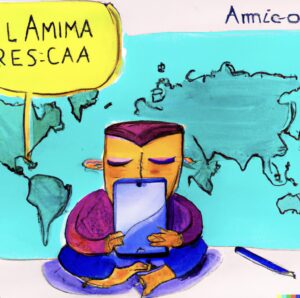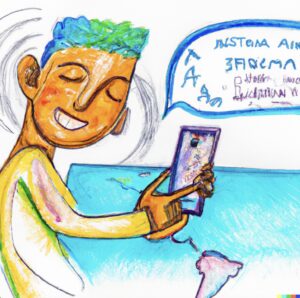Editor’s note: This story is part of a series of articles produced by students taking NYU’s Media Law and Ethics class with a focus on generative artificial intelligence. Students were challenged to come up with novel uses for AI to advance the field of journalism.
(SANTIAGO, Chile) —Everyone seems to be talking about Artificial Intelligence (AI) these days: some with an apocalyptic tone, and others with enthusiastic hope. Undeniably, as with any new technology, this one has either the potential to harm people (and journalism), or to be harnessed in ways that unlock unprecedented benefits, connect communities, and allow easier and more effective learning and creation. This, however, poses the challenge of debating how AI should be integrated into our lives, and what type of products or projects can bring about these beneficial consequences -and not the apocalyptic ones.

Created with Dall-E
This evidently also applies to journalism. How can journalists use AI in ways that enhance their work and journalism’s contribution to healthier democracies?
One of the millions of possibilities lies in AI-powered translation tools, which can break down language barriers and facilitate a broader reach for news stories. This not only allows information to reach different audiences but also builds an intercultural approach to journalism, where dialogue between different cultures is fostered through journalism. Journalists reporting from Mexico can use AI to translate their articles into Portuguese, allowing them to be accessible and relevant to readers in Brazil, thereby promoting cross-cultural understanding. Or, as this project does, translating articles in Spanish to English for an English-speaking audience.

Created with Dall-E
Bringing people together through news
This project proposes one such way in which artificial intelligence can bring people together. Some of ChatGPT’s many talents are translating, summarizing, and changing the tone of a piece of text. This can all be channeled to rapidly create tweets and Instagram posts based on news articles. Thus, L(AI)tin America News Updates is social media content created through automation and AI, by summarizing, translating, and editing news that is originally in Spanish.
This project strives to maintain journalistic integrity by following journalistic principles: attribution, fact-checking, fairness, and thorough editing, among others.
The Twitter account @AILatAmNews shares news articles from across the region as soon as they are published. This is done by linking RSS Feeds to Chat GPT through automation programs and asking the chatbot to do the following with the news articles:
1. Create a single tweet using the following prompt: “Generate one paragraph in English of a maximum of 200 characters, integrating hashtags and emojis, of the main points of this article, using AP style and attribution.” As these are simpler, they are automatically published once an article appears on an RSS feed, but are revised by the journalist in charge of the project afterward.
2. Create a “thread” using the following prompt: “Generate three paragraphs of a maximum of 240 characters each (in a Twitter thread format), with hashtags, of the following: A translation to English of the main points of the article, citing one relevant quote, using AP style and attribution.” These are more complex and therefore are not automatically published. Instead, Chat GPT’s responses are sent to a Google Spreadsheet, where the most relevant stories are then selected, fact-checked, copyedited, and published.
The final result is the following:
Also, the Instagram @l.ai.tinamericanewsproject uses the same Google Spreadsheet to bulk-create graphic content for Instagram, such as the following:
Ver esta publicación en Instagram
Hopefully, this project will bring more international awareness to current events in Latin America.






